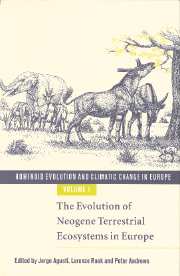Book contents
- Frontmatter
- Contents
- List of contributors
- Acknowledgements: The European Science Foundation
- 1 Introduction
- PART I Palaeogeography of the circum-Mediterranean region
- PART II Miocene mammalian successions
- 5 A critical re-evaluation of the Miocene mammal units in Western Europe: dispersal events and problems of correlation
- 6 Large mammals from the Vallesian of Spain
- 7 Trends in rodent assemblages from the Aragonian (early–middle Miocene) of the Calatayud-Daroca Basin, Aragon, Spain
- 8 The Late Miocene small mammal succession from France, with emphasis on the Rhône Valley localities
- 9 Late Miocene mammals from Central Europe
- 10 An overview on the Italian Miocene land mammal faunas
- 11 The Miocene large mammal succession in Greece
- 12 Chronology and mammal faunas of the Miocene Sinap Formation, Turkey
- 13 The Late Miocene small mammal succession in Ukraine
- PART III Palaeoenvironments: non-mammalian evidence
- PART IV Palaeoenvironments: mammalian evidence
- Index
6 - Large mammals from the Vallesian of Spain
from PART II - Miocene mammalian successions
Published online by Cambridge University Press: 15 December 2009
- Frontmatter
- Contents
- List of contributors
- Acknowledgements: The European Science Foundation
- 1 Introduction
- PART I Palaeogeography of the circum-Mediterranean region
- PART II Miocene mammalian successions
- 5 A critical re-evaluation of the Miocene mammal units in Western Europe: dispersal events and problems of correlation
- 6 Large mammals from the Vallesian of Spain
- 7 Trends in rodent assemblages from the Aragonian (early–middle Miocene) of the Calatayud-Daroca Basin, Aragon, Spain
- 8 The Late Miocene small mammal succession from France, with emphasis on the Rhône Valley localities
- 9 Late Miocene mammals from Central Europe
- 10 An overview on the Italian Miocene land mammal faunas
- 11 The Miocene large mammal succession in Greece
- 12 Chronology and mammal faunas of the Miocene Sinap Formation, Turkey
- 13 The Late Miocene small mammal succession in Ukraine
- PART III Palaeoenvironments: non-mammalian evidence
- PART IV Palaeoenvironments: mammalian evidence
- Index
Summary
Introduction
The fossil record of Neogene macromammals is especially rich in Spain. Localities bearing mammal remains are easily found in several large continental Tertiary basins with long-detailed time series and highly exposed strata. However, the Vallesian record is only well documented and available in two small, marginal basins.
The Vallés-Penedés Basin (Cataluña), where this mammal age was defined (Crusafont, 1950; Aguirre et al., 1975; Aguirre, 1981; Moyà-Solà & Agustí, 1990a; Agustí & Moyà-Solà, 1991). It has a rich continuous record ranging from the Upper Aragonian till the Lower Turolian.
The Calatayud-Teruel Basin (Aragón), which covers the same time span but within two areas, Daroca up to the end of the Lower Vallesian, and Teruel with fossil sites from the beginning of the Upper Vallesian onwards (Daams et al., 1988; Alcalá, 1994; Dam, 1998).
Other basins – lacking a continuous record – present very important isolated Vallesian localities. That is the case of Los Valles de Fuentidueña from the Upper Vallesian of the Duero Basin (Alberdi et al., 1981), or Cerro de los Batallones site in the Upper Vallesian of the Tagus Basin where an incredible amount of carnivore remains have already been unearthed (Morales et al., 1992).
Fossil faunas
The beginning of the Vallesian is marked by the entrance of the immigrant fossil equid Hipparion (see Sen, 1990, for Hipparion event disscusion) that came from North America to replace a previous immigrant equid Anchitherium. Their coexistence has been only registered once, in the fossil site of Nombrevilla 1 in the Calatayud-Teruel Basin.
The Aragonian–Vallesian boundary reveals a strong change in the composition of the macromammal fossil faunas.
- Type
- Chapter
- Information
- Hominoid Evolution and Climatic Change in Europe , pp. 113 - 126Publisher: Cambridge University PressPrint publication year: 1999
- 5
- Cited by

